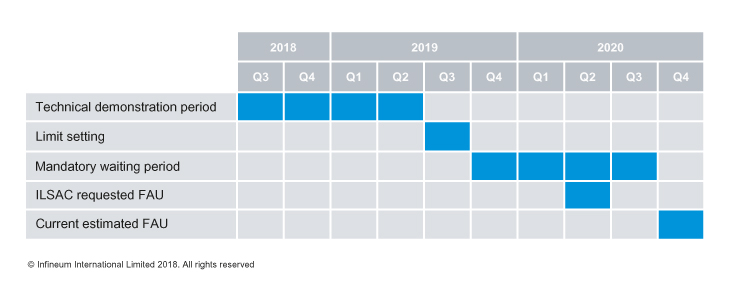Specification updates
ACEA HD Sequences released
22 January 2025
Please note this article was published in September 2018 and the facts and opinions expressed may no longer be valid.
25 September 2018
Preferred ILSAC April 2020 timing may be hard to achieve

Although the AOAP has not met since June, summarising the status at the September meeting showed a good deal of work progressed over the summer as well as highlighted the remaining challenges.
There are still three main activities that need to be completed in the ILSAC GF-6 development timeline: the technology demonstration period, limit setting, and mandatory waiting period. The combined duration of these activities would put the first allowable use (FAU) at end of September 2020. ILSAC has stated that April 2020 is their preferred date. As Joan Evans, Infineum Americas IL Manager reported at AOAP: all stakeholders have invested heavily in ILSAC GF-6 and want the new specification to commence as soon as practical.
At the June AOAP meeting it was agreed that the technical demonstration period could start – but what is more important here is when it will finish. To facilitate the process, a plan of communication is being discussed between ILSAC and ACC.

There is already immense pressure on the timeline to close this gap. However, ACC has also raised potential concerns on three key issues that could impact the timing further:
AOAP reviewed past specification introductions and asked for a bench test status report to eliminate any capacity/testing issues for ILSAC GF-6 implementation. Presented by Dennis Gaal from ExxonMobil, the bench test status report said there are no areas of concern for the bench tests and that there is a robust process in place to handle any issues that may arise. This is important because, in the past, bench tests have not been analysed for potential capacity or availability issues when new specifications were introduced and this has caused challenges and/or delays. This work should help to smooth the introduction of ILSAC GF-6.
ILSAC GF-6 is proving to be the most complex and costly passenger car motor oil category. The need to meet the performance requirements of two new and five replacement engine tests while balancing the new durability requirements, deposit improvements against new fuel economy requirements is extremely challenging. Formulations must be balanced into a single ILSAC GF-6 core chemistry that matches the desired performance limits, base stock selection and viscosity grades.
The technology demonstration period is essential to assess if it is possible to pass all of the tests in the category, in all the viscosity grades and base stock types.
Formulation requires all the tests to be ready, fully defined and stable for the majority of the technical demonstration period. Right now the key area of concern is the Sequence IVB. While Toyota says that all this analysis can be completed and approved by the Surveillance Panel before the October AOAP Meeting, this may be overly optimistic, which could introduce further delay.
In our view, meeting the current ILSAC GF-6 draft specification is a challenge both in terms of the technical performance of a formulation and time required to complete the work to define this formulation space. Compromise will be necessary by all the stakeholders to meet the specification introduction timing.
In terms of base oil interchange (BOI) and viscosity grade read across (VGRA), Sequence IX BOI/VGRA was put in place for API SN PLUS.
API BOI/VGRA Task Force is meeting regularly to review matrix data and the statisticians’ analyses for the ILSAC GF-6 tests. Lubricants Group agreed to issue ballots for read across for the Sequence VIF. Currently in process are the Sequence VH, IIIH, and X datasets and proposed guidelines. The Sequence VIE matrix testing is close to completion and the Sequence IVB is awaiting ASTM Surveillance Panel guidance before commencing the matrix.
The Sequence IVB Task Force has been meeting frequently in the past two months and have completed the FEWMEOT measurement procedure and made significant progress on other outstanding issues. However, it remains to be seen if these changes have improved the test and much work is still required by the statisticians here – with the analysis still to be defined. Other outstanding items, which need to be completed include: development of a lubricant test monitoring system (LTMS) for FEWMEOT, plus the definitions for lobe failure and oil consumption and the engine life guideline all need to be approved and validated.
Batch 5 pistons have brought the test back to the precision matrix severity and everything is running on target, with no issues.
LTMS and registration are both in place. However, the existing fuel batch will all be gone at the San Antonio test labs during Q4, creating a sense of urgency to approve a new fuel batch. The test matrix for this new fuel batch is well underway and the data reported to date look promising. A target of approving this by the end of October seems realistic, which would result in minimal disruption to the technology demonstration effort.
The new batch of pistons (BC) were tried and found to be too severe and, as a result, a new batch of BB pistons is being made. Ford is ordering a seven-year supply of these pistons. Reference oil 222 is no longer available and will be replaced by Reference oil 224 with a target of 5 events per test.
This test is not sensitive to piston batch and will only use engines with BC pistons.
Insight will keep readers up to date with future ILSAC GF-6 progress – sign up here to receive updates to your inbox.
Sign up to receive monthly updates via email